Hungarian film actress (Gräfin) Agnes Esterhazy (1891-1956) worked mainly in the silent cinema of Austria and Germany. The countess appeared in more than 30 films between 1920 and 1943.
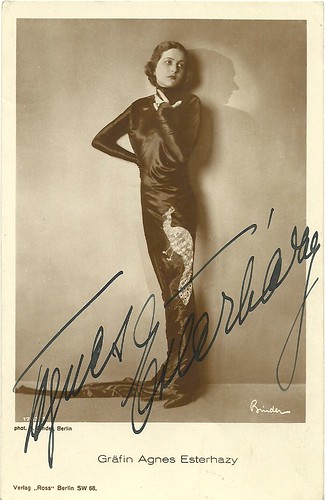
German postcard by Ross Verlag, no. 1743/1, 1927-1928. Photo: Alex Binder. Collection: Didier Hanson.
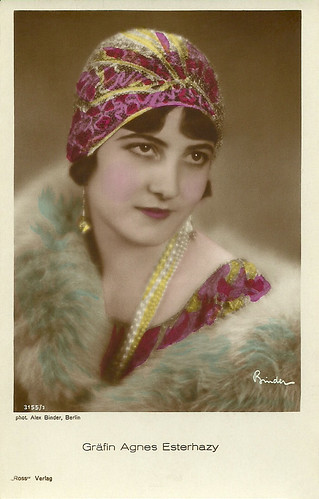
German postcard by Ross Verlag, no. 3155/1, 1928-1929. Photo: Alex Binder. Collection: Didier Hanson.

German postcard by Ross Verlag, Berlin, no. 1015/1, 1927-1928. Photo: Alex Binder, Berlin.
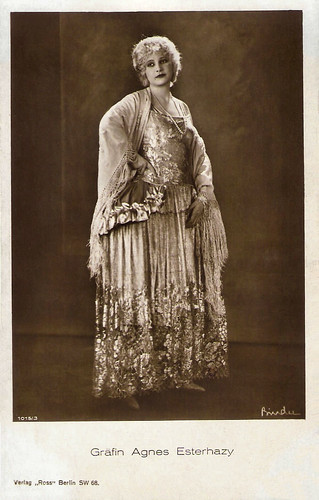
German postcard by Ross Verlag, Berlin, no. 1015/3, 1927-1928. Photo: Alex Binder.
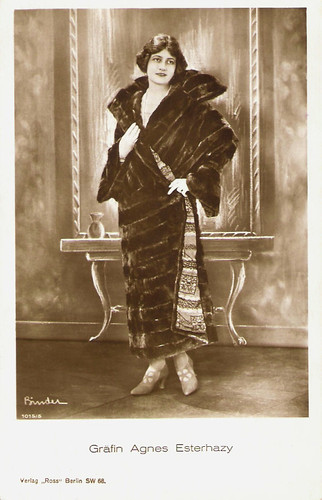
German postcard by Ross Verlag,Berlin, no. 1015/5, 1927-1928. Photo: Alex Binder.
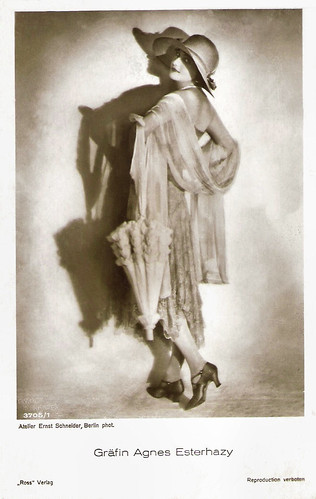
German postcard by Ross Verlag, no. 3705/1, 1928-1929. Photo: Ernst Schneider, Berlin.
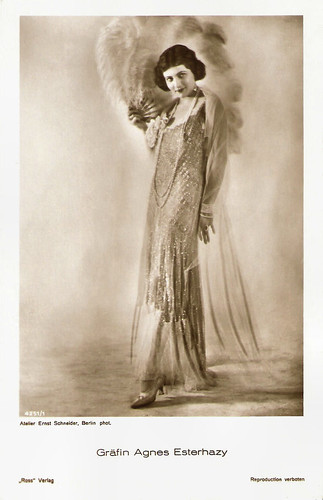
German postcard by Ross Verlag, no. 4251/3, 1929-1930. Photo: Ernst Schneider, Berlin.
Agnes Esterhazy was born Agnes Gräfin Josika von Branyitska in Klausenburg/Kolozsvár, Austria-Hungary (now Cluj-Napoca, Romania), in 1891 (some sources say 1898). She was a real countess, the daughter of Count Josika von Branyitska and his wife.
In Budapest she took acting classes from singer/actress Ilka Pálmay and worked for the Városi Színház (the Municipal theater). She made her first film appearance in the Hungarian film A szerelem mindent legyőz/Love Surrenders Everything (László Márkus, 1920).
In 1923 she was invited by Sascha-Film to come to Vienna. There she made the Arthur Schnitzler adaptation Der Junge Medardus/Young Medardus (1923), directed by Mihaly Kertész, the later Michael Curtiz. This was a historical film about a young man from Vienna who wants to fight against the Napoleon troops.
Then Esterhazy left for Munich and soon moved further to Berlin, the European film capital at the time. In Berlin she appeared for Trianon-Film in Zwei Menschen/Two People (Hanns Schwarz, 1924) opposite Olaf Ford, and Nanon (Hanns Schwarz, 1924) with Harry Liedtke.
She appeared in such silent classics as Die freudlose Gasse/The Joyless Street (Georg Wilhelm Pabst, 1925) starring Asta Nielsen and the young Greta Garbo, and the horror film Der Student von Prag/The Man Who Cheated Life (Henrik Galeen, 1926) featuring Conrad Veidt.
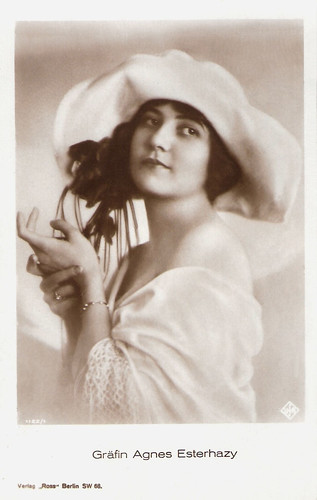
German postcard by Ross Verlag, no. 1122/1, 1927-1928. Photo: Ufa.
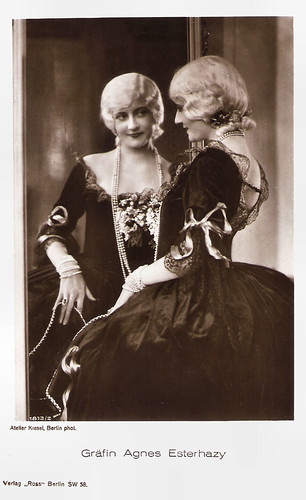
German postcard by Ross Verlag, no. 1813/2, 1927-1928. Photo: Atelier Kiesel, Berlin.

German postcard by Ross Verlag, no. 4073/2, 1929-1930. Photo: Atelier Ernst Schneider.
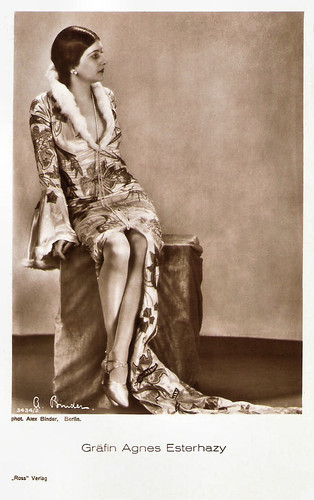
German postcard by Ross Verlag, no. 3434/2, 1928-1929. Photo: Alex Binder, Berlin.
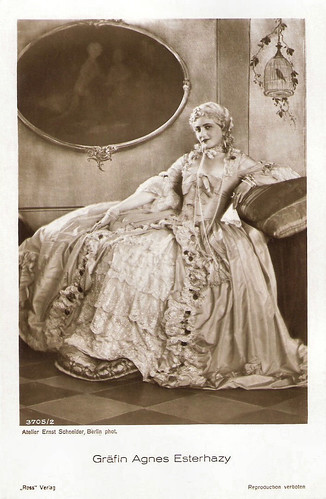
German postcard by Ross Verlag, no. 3705/2, 1928-1929. Photo: Atelier Ernst Schneider.
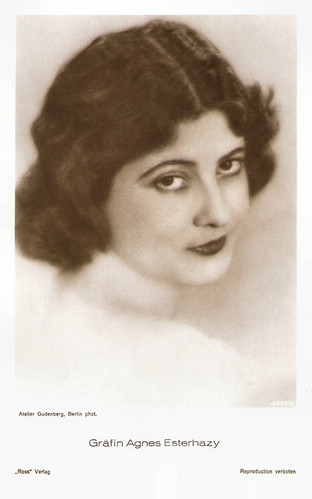
German postcard by Ross Verlag, no. 4869/2, 1929-1930. Photo: Atelier Gudenberg, Berlin.
Agnes Esterhazy played many supporting parts in silent German films of the 1920s and eventually she also appeared in leading parts in such films as Die Spielerin/The Player (Graham Cutts, 1927), and Der Bettelstudent/The Beggar Student (Jakob Fleck, Luise Fleck, 1927), both with Harry Liedtke.
Under the direction of Karl Grune she appeared in the historical drama Marquis d'Eon, der Spion der Pompadour/Marquis d'Eon, the Spy of Pompadour (Karl Grune, 1928) with Liane Haid.
But with the arrival of the sound film, her film career practically ended. She appeared in a few early sound films such as the comedy Die Garde-Diva (Curt Blachnitzky, 1929) with Georg Alexander, and Liebe und Champagner/Love and Champagne (Robert Land, 1930) with Iván Petrovich, but then she retired from the cinema.
The following decade she worked on stage, especially in Ostrau. In 1943 she appeared for one last time in a film, in Gabriele Dambrone (Hans Steinhoff, 1943) with Gusti Huber. She was married to actor Fritz Schulz.
Agnes Esterhazy died in Budapest, Hungary (some sources say: München (Munich), Germany), in 1956.

German postcard by Ross Verlag, Berlin, no. 91/1. Photo: Aafa. Publicity still for Der Bettelstudent/The Beggar Student (Jacob Fleck, Luise Fleck, 1927) with Harry Liedtke.
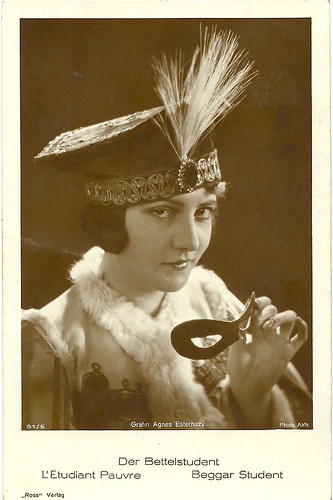
German postcard by Ross Verlag, Berlin, no. 91/5. Photo: Aafa. Publicity still for Der Bettelstudent/The Beggar Student (Jacob Fleck, Luise Fleck, 1927). Collection: Didier Hanson.
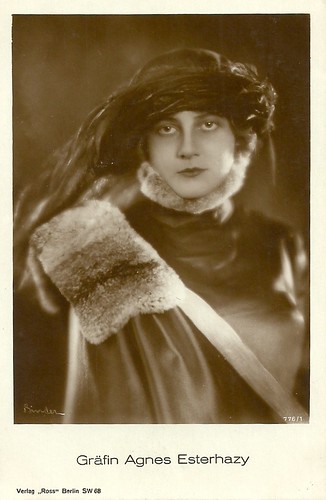
German postcard by Ross Verlag, no. 776/1, 1925-1926. Photo: Alex Binder.
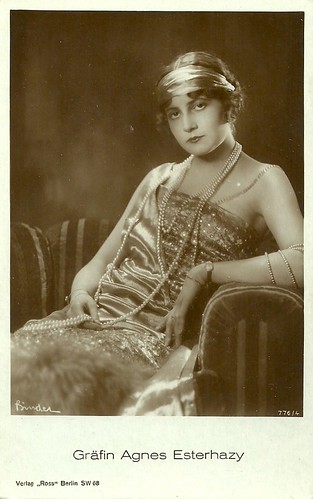
German postcard by Ross Verlag, no. 776/4, 1925-1926. Photo: Alex Binder.
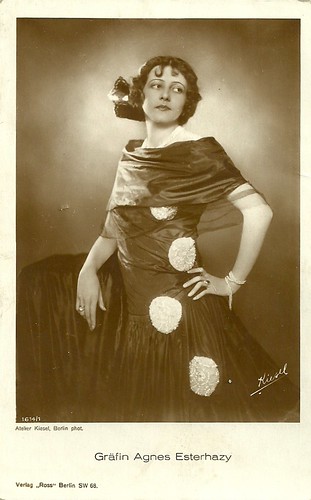
German postcard by Ross Verlag, no. 1614/1, 1927-1928. Photo: Atelier Kiesel, Berlin.
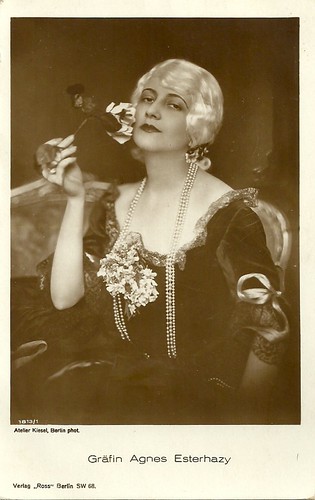
German postcard by Ross Verlag, no. 1813/1, 1927-1928. Photo: Atelier Kiesel, Berlin.
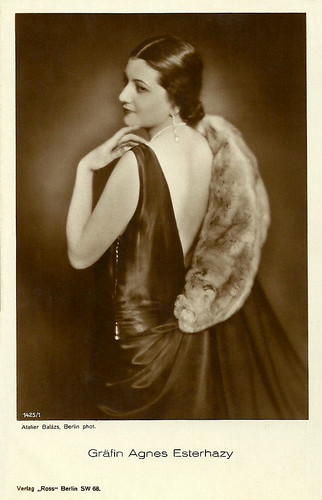
German postcard by Ross Verlag, no. 1425/1, 1927-1928. Photo: Atelier Balàzs, Berlin.

German postcard by Ross Verlag, no. 3434/1, 1928-1929. Photo: Alex Binder, Berlin.
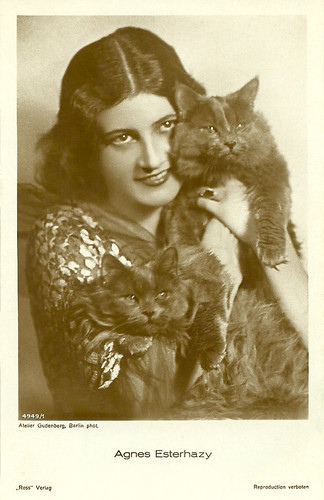
German postcard by Ross Verlag, no. 4949/1, 1929-1930. Photo: Atelier Gudenburg. Collection: Didier Hanson.

French postcard by Cinémagazine-Edition, no. 273.
Sources: Thomas Staedeli (Cyranos), Wikipedia and IMDb.
This post was last updated on 21 February 2024.

German postcard by Ross Verlag, no. 1743/1, 1927-1928. Photo: Alex Binder. Collection: Didier Hanson.

German postcard by Ross Verlag, no. 3155/1, 1928-1929. Photo: Alex Binder. Collection: Didier Hanson.

German postcard by Ross Verlag, Berlin, no. 1015/1, 1927-1928. Photo: Alex Binder, Berlin.

German postcard by Ross Verlag, Berlin, no. 1015/3, 1927-1928. Photo: Alex Binder.

German postcard by Ross Verlag,Berlin, no. 1015/5, 1927-1928. Photo: Alex Binder.

German postcard by Ross Verlag, no. 3705/1, 1928-1929. Photo: Ernst Schneider, Berlin.

German postcard by Ross Verlag, no. 4251/3, 1929-1930. Photo: Ernst Schneider, Berlin.
Vienna - Munich - Berlin
Agnes Esterhazy was born Agnes Gräfin Josika von Branyitska in Klausenburg/Kolozsvár, Austria-Hungary (now Cluj-Napoca, Romania), in 1891 (some sources say 1898). She was a real countess, the daughter of Count Josika von Branyitska and his wife.
In Budapest she took acting classes from singer/actress Ilka Pálmay and worked for the Városi Színház (the Municipal theater). She made her first film appearance in the Hungarian film A szerelem mindent legyőz/Love Surrenders Everything (László Márkus, 1920).
In 1923 she was invited by Sascha-Film to come to Vienna. There she made the Arthur Schnitzler adaptation Der Junge Medardus/Young Medardus (1923), directed by Mihaly Kertész, the later Michael Curtiz. This was a historical film about a young man from Vienna who wants to fight against the Napoleon troops.
Then Esterhazy left for Munich and soon moved further to Berlin, the European film capital at the time. In Berlin she appeared for Trianon-Film in Zwei Menschen/Two People (Hanns Schwarz, 1924) opposite Olaf Ford, and Nanon (Hanns Schwarz, 1924) with Harry Liedtke.
She appeared in such silent classics as Die freudlose Gasse/The Joyless Street (Georg Wilhelm Pabst, 1925) starring Asta Nielsen and the young Greta Garbo, and the horror film Der Student von Prag/The Man Who Cheated Life (Henrik Galeen, 1926) featuring Conrad Veidt.

German postcard by Ross Verlag, no. 1122/1, 1927-1928. Photo: Ufa.

German postcard by Ross Verlag, no. 1813/2, 1927-1928. Photo: Atelier Kiesel, Berlin.

German postcard by Ross Verlag, no. 4073/2, 1929-1930. Photo: Atelier Ernst Schneider.

German postcard by Ross Verlag, no. 3434/2, 1928-1929. Photo: Alex Binder, Berlin.

German postcard by Ross Verlag, no. 3705/2, 1928-1929. Photo: Atelier Ernst Schneider.

German postcard by Ross Verlag, no. 4869/2, 1929-1930. Photo: Atelier Gudenberg, Berlin.
Supporting and leading parts
Agnes Esterhazy played many supporting parts in silent German films of the 1920s and eventually she also appeared in leading parts in such films as Die Spielerin/The Player (Graham Cutts, 1927), and Der Bettelstudent/The Beggar Student (Jakob Fleck, Luise Fleck, 1927), both with Harry Liedtke.
Under the direction of Karl Grune she appeared in the historical drama Marquis d'Eon, der Spion der Pompadour/Marquis d'Eon, the Spy of Pompadour (Karl Grune, 1928) with Liane Haid.
But with the arrival of the sound film, her film career practically ended. She appeared in a few early sound films such as the comedy Die Garde-Diva (Curt Blachnitzky, 1929) with Georg Alexander, and Liebe und Champagner/Love and Champagne (Robert Land, 1930) with Iván Petrovich, but then she retired from the cinema.
The following decade she worked on stage, especially in Ostrau. In 1943 she appeared for one last time in a film, in Gabriele Dambrone (Hans Steinhoff, 1943) with Gusti Huber. She was married to actor Fritz Schulz.
Agnes Esterhazy died in Budapest, Hungary (some sources say: München (Munich), Germany), in 1956.

German postcard by Ross Verlag, Berlin, no. 91/1. Photo: Aafa. Publicity still for Der Bettelstudent/The Beggar Student (Jacob Fleck, Luise Fleck, 1927) with Harry Liedtke.

German postcard by Ross Verlag, Berlin, no. 91/5. Photo: Aafa. Publicity still for Der Bettelstudent/The Beggar Student (Jacob Fleck, Luise Fleck, 1927). Collection: Didier Hanson.

German postcard by Ross Verlag, no. 776/1, 1925-1926. Photo: Alex Binder.

German postcard by Ross Verlag, no. 776/4, 1925-1926. Photo: Alex Binder.

German postcard by Ross Verlag, no. 1614/1, 1927-1928. Photo: Atelier Kiesel, Berlin.

German postcard by Ross Verlag, no. 1813/1, 1927-1928. Photo: Atelier Kiesel, Berlin.

German postcard by Ross Verlag, no. 1425/1, 1927-1928. Photo: Atelier Balàzs, Berlin.

German postcard by Ross Verlag, no. 3434/1, 1928-1929. Photo: Alex Binder, Berlin.

German postcard by Ross Verlag, no. 4949/1, 1929-1930. Photo: Atelier Gudenburg. Collection: Didier Hanson.

French postcard by Cinémagazine-Edition, no. 273.
Sources: Thomas Staedeli (Cyranos), Wikipedia and IMDb.
This post was last updated on 21 February 2024.
No comments:
Post a Comment